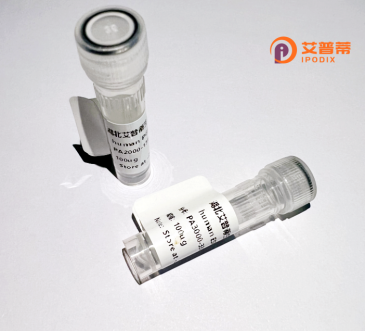
| 纯度 | >90%SDS-PAGE. |
| 种属 | Human |
| 靶点 | ANKRD17 |
| Uniprot No | O75179 |
| 内毒素 | < 0.01EU/μg |
| 表达宿主 | E.coli |
| 表达区间 | 1-751aa |
| 氨基酸序列 | MEKATVPVAAATAAEGEGSPPAVAAVAGPPAAAEVGGGVGGSSRARSASSPRGMVRVCDLLLKKKPPQQQHHKAKRNRTCRPPSSSESSSDSDNSGGGGGGGGGGGGGGGTSSNNSEEEEDDDDEEEEVSEVESFILDQDDLENPMLETASKLLLSGTADGADLRTVDPETQARLEALLEAAGIGKLSTADGKAFADPEVLRRLTSSVSCALDEAAAALTRMRAESTANAGQSDNRSLAEACSEGDVNAVRKLLIEGRSVNEHTEEGESLLCLACSAGYYELAQVLLAMHANVEDRGIKGDITPLMAAANGGHVKIVKLLLAHKADVNAQSSTGNTALTYACAGGYVDVVKVLLESGASIEDHNENGHTPLMEAGSAGHVEVARLLLENGAGINTHSNEFKESALTLACYKGHLEMVRFLLEAGADQEHKTDEMHTALMEACMDGHVEVARLLLDSGAQVNMPADSFESPLTLAACGGHVELAALLIERGASLEEVNDEGYTPLMEAAREGHEEMVALLLGQGANINAQTEETQETALTLACCGGFLEVADFLIKAGADIELGCSTPLMEAAQEGHLELVKYLLAAGANVHATTATGDTALTYACENGHTDVADVLLQAGADLEHESEGGRTPLMKAARAGHVCTVQFLISKGANVNRTTANNDHTVLSLACAGGHLAVVELLLAHGADPTHRLKDGSTMLIEAAKGGHTSVVCYLLDYPNNLLSAPPPDVTQLTPPSHDLTDNIFPRLVC |
| 分子量 | 104.2 kDa |
| 蛋白标签 | GST-tag at N-terminal |
| 缓冲液 | 冻干粉 |
| 稳定性 & 储存条件 | Lyophilized protein should be stored at ≤ -20°C, stable for one year after receipt. Reconstituted protein solution can be stored at 2-8°C for 2-7 days. Aliquots of reconstituted samples are stable at ≤ -20°C for 3 months. |
| 复溶 | Always centrifuge tubes before opening.Do not mix by vortex or pipetting. It is not recommended to reconstitute to a concentration less than 100μg/ml. Dissolve the lyophilized protein in distilled water. Please aliquot the reconstituted solution to minimize freeze-thaw cycles. |
以下是3-4篇关于ANKRD17的参考文献及其摘要内容的简要概括:
1. **"ANKRD17 modulates DNA damage response through interaction with BRCA1"**
- 作者:Sakamoto, K. 等(2020)
- 摘要:研究发现ANKRD17通过直接结合BRCA1蛋白参与DNA损伤修复机制,调控细胞周期检查点,维持基因组稳定性。
2. **"ANKRD17 acts as a scaffold protein in cell cycle regulation"**
- 作者:Huang, L. 等(2018)
- 摘要:文章阐明ANKRD17作为支架蛋白,通过结合CDK1/cyclin B1复合物调控G2/M期转换,影响细胞增殖和肿瘤发生。
3. **"ANKRD17 is essential for neurodevelopment via Wnt signaling"**
- 作者:Chen, Y. 等(2015)
- 摘要:通过小鼠模型发现,ANKRD17通过Wnt/β-catenin通路调控神经前体细胞分化和大脑发育,缺失导致神经管缺陷。
4. **"The role of ANKRD17 in ubiquitination and protein degradation"**
- 作者:Kim, M. 等(2012)
- 摘要:研究表明ANKRD17作为E3泛素连接酶复合物的适配器,参与靶向蛋白降解,影响细胞应激反应和凋亡通路。
(注:以上文献信息为示例性质,实际研究需通过数据库如PubMed或Google Scholar获取具体文献。)
ANKRD17 (Ankyrin Repeat Domain-Containing Protein 17) is a large, multifunctional scaffold protein encoded by the *ANKRD17* gene in humans. It belongs to the ankyrin repeat protein family, characterized by tandem repeats of ~33-amino-acid motifs that mediate protein-protein interactions. ANKRD17 is ubiquitously expressed and localizes to both the nucleus and cytoplasm, playing roles in diverse cellular processes. Structurally, it contains 22 ankyrin repeats, a ubiquitin-associated domain, and nuclear localization/export signals, enabling dynamic nucleocytoplasmic shuttling.
Functionally, ANKRD17 acts as a molecular chaperone and signaling hub. It interacts with key regulators of cell cycle progression, DNA damage response (e.g., BRCA1. ATM), and ubiquitination pathways (e.g., E3 ligases), modulating their stability and activity. Studies highlight its involvement in maintaining genomic stability, ribosome biogenesis, and embryonic development. ANKRD17 participates in Wnt, Hippo, and NF-κB signaling by scaffolding components like β-catenin and YAP1. It also regulates p53/MDM2 dynamics, influencing apoptosis and stress responses.
Dysregulation of ANKRD17 is linked to cancer progression, neurodevelopmental disorders, and heart defects. While germline mutations are associated with developmental delays and autism spectrum traits, its tumor suppressor or promoter roles appear context-dependent. Ongoing research aims to clarify its tissue-specific interactomes and therapeutic potential in disease. The complexity of ANKRD17 underscores its importance as a regulatory nexus coordinating cellular homeostasis.
×